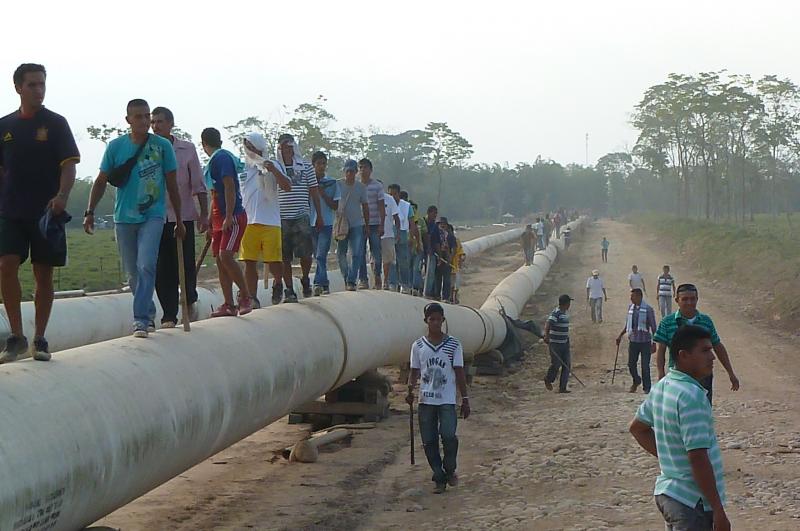By Colombia Informa; translation by Molly Fohn
After two weeks of peaceful protesting against oil exploitation in Arauca, on February 12 that department’s social organizations began a strike announced a few days earlier as a response to the repeated broken promises by the national government and transnational companies.
The last attempt at dialogue took place on Monday, February 11, between the Commission’s spokespeople (composed of a delegation of indigenous people, peasants, youth, women, workers and community members) and representatives of the Minister of the Interior, as well as oil companies that operate in the region, with the goal of establishing the conditions that would allow the fulfillment of those promises that they’ve been making since May 2012.
The repeated lack of follow-through by the government and businesses, and the delay in the negotiation process caused the fracture in the space for dialogue, followed by the use of state force: approximately 1,200 members of the Mobile Anti-Disturbance Squadron (the ESMAD in Spanish) arrived to violently evict the communities at the protest sites.
The first act occurred on the walkway San Isidro, over the de Tame road toward the Arauca capital, at the gate to the petroleum complex Caricare, which is used by the transnational company OXY, where ESMAD, the Police, and the Army assaulted the mobilized communities by setting fires to the surrounding pastures, discharging their weapons, destroying common buildings (a school), taking away the food supplies to the protestors, and beating and retaining four people.
As a result of the violence, a pregnant indigenous woman who was passing through lost her baby because of the effects of the tear gas, and had to receive emergency attention at a medical center.
The police had kept local and national reporters from contacting CM&, RCN, and other local media that moved to Caricare; the national army set up a checkpoint in the sector of Lipa that prohibited the passage of reporters “for security reasons.” It should be noted that in the Quimbo (Huila) events the police also restricted the presence of the media and acted out a series of violations of basic human rights and International Humanitarian Rights (DIH).
In the face of the this situation, the Human Rights Foundation Joel Sierra posted an Urgent Action which stated its concern for the detention of people, aggression and brutal violence exercised against the peasants and indigenous peoples, the infractions of the International Humanitarian Rights committed by the police to violate and destroy civil installations, and the removal of supplies for feeding those protesting. The Foundation also insisted that the Colombian State respect human rights and the International Humanitarian Rights norms.
In similar form, Urgent Action denounced a series of violations to the protestors’ rights by the police, whose members have dedicated themselves to constantly photograph those that participate in the protests, have retained, interrogated, and reported some of them, and have appeared in civilian clothing and armed in the middle of the night at the edges of the protest sites, among other cases.
In the rest of the protest sites, like the gate to the petroleum complex of Caño Limón in the municipality of Arauca, the town of Caricare in Arauquita, the bicentennial pipeline in Tamacay and el Tigre (Tame) and in Villamaga (Saravena) and the fire substation of Banadías (Saravena), the authorities have sent contingents from the army, the national police, and the ESMAD, because they fear the same will happen in those places that happened in Caricare.
It’s important to note that at this time people and vehicles cannot travel by land to get outside of the department of Arauca by the only two major roads (Casanare and Norte de Santander), and all commerce and activity is completely paralyzed in that region of the country.
From Upside Down World: http://upsidedownworld.org/main/news-briefs-archives-68/4140-colombia-riot-police-attack-communities-protesting-oil-exploitation-in-arauca-


Reblogged this on There Are So Many Things Wrong With This.